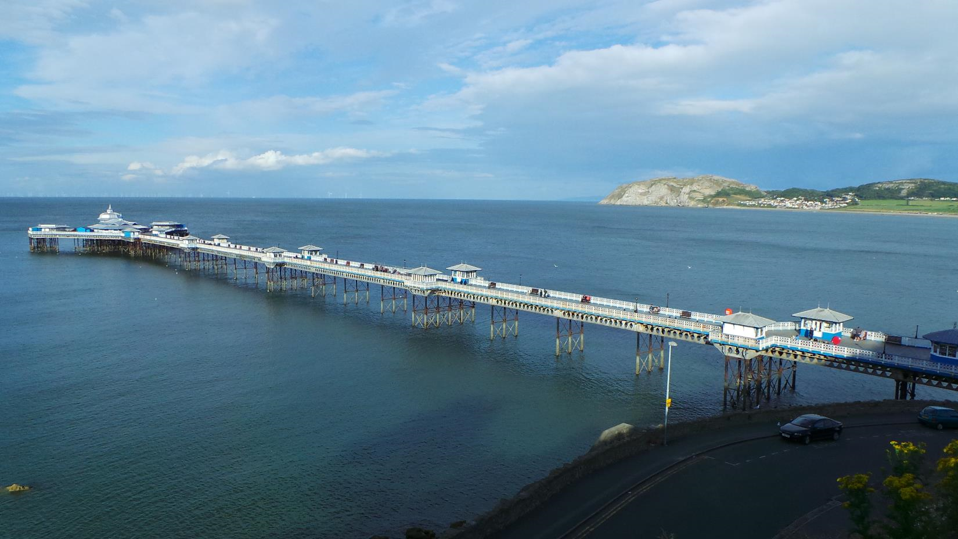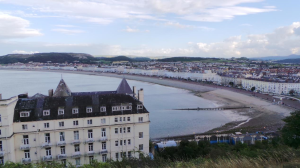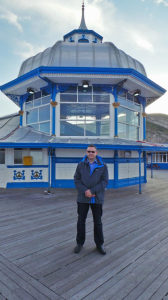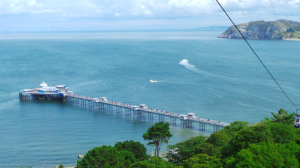
I spent a week with my father in Llandudno on the North Wales coast earlier this month. It was really great to be back in this part of the world, which I had visited many times in the past – as a child with my family and later as an adult – but I had never visited this particular town before. My father is from Wales but he had not been here before either, so we were both able to enjoy discovering the delights of the town and the surrounding country for the first time. It is an old seaside resort that was made popular by the Victorians. The town is located on a peninsula that sticks out into the Irish Sea and lies on a flat isthmus of land between the Welsh mainland and the Great Orme, a vast limestone headland. The English name – Great Orme – comes from the Old Norse word for sea serpent. In the Welsh language it is called Pen y Gogarth. During our visit I thought the two most distinguishing features of the town were the long curved row of Victorian hotels along the seafront, with a wide promenade between the hotels and the beach, and the pier that was built in 1877, with further additions completed in 1884.
When we arrived in the town after a long drive across England and North Wales, including a lunchtime stop in Stoke-on-Trent to visit the Wedgwood pottery, the row of houses and hotels that line the seafront just seemed endless. These buildings are painted white and a variety of light pastel colors. We learned during an open-topped bus tour later in the week that the town requires houses here to be painted in colors from an approved color palette, which ensures the town keeps its traditional and unified character. The houses are mostly fine examples of Victorian architecture and are extremely well preserved. In fact, visiting this town feels like stepping back in time. The place is like a living museum that obviously strives hard to maintain its Victorian atmosphere, complete with traditional entertainments such as the pier, donkey rides, punch and judy shows, and trams that take visitors to the summit of the Great Orme. The trams started operation in 1902, at a time when several other tram services were operating around town.

A view of Llandudno from above the Grand Hotel. Most of the buildings lining the seafront are Victorian-era hotels that provide spectacular views of the sea.
We stayed at The Beach House guest house. This hotel is located at the Great Orme end of the town at 82 Church Walks. To get there we just had to drive to the end of the seafront road and turn left at the roundabout near the entrance to the pier. Our room was fine for the two of us. It had a large bay window and we had a good view of the sea. Every morning we had a hearty cooked breakfast at the hotel, served by a friendly Irish woman who had married a local man and had lived in the town for years. After we arrived in the town, one of the first things we wanted to do was to take a stroll along the pier.
The “golden age” of pier construction was during the nineteenth century when the Victorians built them as leisure venues as well as to provide berthing points for sea-going steamers. At one time there were dozens of piers around the coast of Britain; indeed, Jim Roberts notes in his book on the history of the town that between 1814 and 1910 eighty-nine piers were built around the coasts of England and Wales. Today, they are quite a rarity, not least because they are prone to fire damage. Only last month, for example, the pier at Eastbourne on the southern England coast caught fire and sustained serious damage. So to come across such a well preserved pier in Llandudno was a real treat. There are two entrances to the pier: one from the seafront promenade and the other from the main entrance at the foot of the Great Orme headland, next to the Grand Hotel, which was once the top hotel in the town and retains much of its original elegance. One day we had coffee in the hotel, which first opened in 1902, and it was worth the visit just to get a sense of what the atmosphere must have been like during the hotel’s heyday. As far as I could tell, everything on the pier was original and is pretty much unchanged since it was first built.

In front of the old concert hall (now an amusement arcade) at the end of the pier. Note the jacket, which I purchased in the town because of the unseasonably cold weather – in August! Fortunately, it wasn’t cold every day.
The main structure of the pier is made from iron, while the walkway is constructed from wooden boards. There are several huts along each side of the pier from which various quality items are sold, including crafts, photographs, herbal remedies and souvenirs. The main building at the end of the pier was originally used as a concert hall but is now an amusement arcade. During our stay, we walked along the pier in the evening when everything was closed as well as during the day, when it was fairly crowded but refreshments were available for purchase at the end of the pier. I preferred our walks in the evening when only a handful of other people were about and we could enjoy the views more peacefully. The pier allows excellent views of the Llandudno shoreline and long row of hotels along the promenade, as well as the cliffs of the Great Orme and the Snowdonia mountains in the distance.
I discovered that a company called Waverley Excursions operates the UK’s last sea-going paddle steamer, called the Waverley, between Liverpool and Llandudno pier. This steamer is very similar to the types of vessels that docked at the Llandudno pier in the 1800s. I would love to make a voyage on this steamer one day and experience first-hand what it must have been like for Victorian travelers. Although the Waverley was first launched as late as 1946, it replaced an earlier vessel that had been lost during the Second World War at Dunkirk. The pier was definitely one of the main highlights of our trip to Llandudno.

Looking down on the pier from one of the cable cars that takes visitors to the top of the Great Orme peninsula.

Excellent looking photos, they’re like postcards. It’s full of information too.
Thank you. The BBC published a story about the Waverley a few days ago. The paddle steamer was going to dock at Llandudno pier after making the journey from Liverpool, but apparently it was unable to dock due to strong winds. See http://www.bbc.com/news/uk-wales-28955458 for more details.